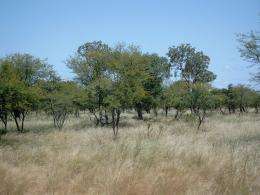Largest-ever scientific camera trapping survey reveals 'secret lives of the Serengeti'

The use of camera traps—remote automatic cameras triggered by heat or motion—has revolutionized wildlife ecology and conservation research. But the large number of images generated through the traps creates the problem of categorizing and analyzing all the images.
For a recent project conducted in the Serengeti National Park, Alexandra Swanson, turned to another relatively new technology—a citizen science platform. The Snapshot Serengeti project asked non-scientist volunteers to review 1.2 million sets of images. A description of the project, 'Snapshot Serengeti, high-frequency annotated camera trap images of 40 mammalian species in an African savanna' has been published in Scientific Data, an online publication of Nature.
'This was the largest camera tracking survey conducted in science to date,' says Swanson, a postdoctoral fellow at the University of Oxford who received her Ph.D. in ecology, evolution and behavior from the University of Minnesota. While most studies typically use 20 to 30 cameras, her team set 225 traps across 1,000 square kilometers in Serengeti National Park, a UNESCO World Heritage site in Tanzania. 'We wanted to study how predators and their prey co-existed across a dynamic landscape,' she says. 'We needed to answer different questions than camera traps had answered previously.'
What she quickly discovered, though, was that she was being buried under 'big data.' 'If we were only interested in lions and leopards, we could have classified those images ourselves, but with hundreds of thousands of images of wildebeests and zebras, we simply couldn't keep up with the photos being produced,' she says. She and then-fellow graduate student Margaret Kosmala partnered with citizen science platform Zooniverse to design, implement, and launch Snapshot Serengeti. More than 28,000 volunteers responded, classifying images, identifying species, counting individuals and characterizing behaviors. Of the 1.2 million collected images, 322,653 contained animals, with 40 separate species identified, including rare animals such as the aardwolf, zorilla and honey badger.
Kosmala, a former ecology, evolution and behavior graduate student and current postdoctoral fellow in the Department of Organismic and Evolutionary Biology at Harvard University, says the project needed a human touch. 'Computer vision research is now on the cusp of being able to recognize animals in camera trap images, but when we started Snapshot Serengeti a few years ago, there was no automated way to identify the animals in our pictures,' she says. 'We needed to rely on the human eye.'
'Without volunteer help, the research wouldn't have been possible,' Swanson says. She was especially impressed with the quality of the data she received. 'Every image was seen by many volunteers, and we created an algorithm to seek consensus in the identifications.' Swanson and her team hope that their methodology and algorithm will contribute to future crowdsourced image processing projects, and that the resulting dataset may be used for further ecological research and education.
The University of Minnesota has already seen the educational benefits of the project. Postdoctoral instructor Annika Moe developed a lab curriculum using the Snapshot Serengeti data. 'It introduces students to exploratory research, where you first collect data and make observations,' Annika says. 'Working this way feeds curiosity and focuses on the creative aspect of science.'
'This project is a great example of how citizen science can contribute to real research,' Swanson says. 'We all know that people are good at pattern recognition, so harnessing the power of volunteers will become increasingly important for ecology studies. We can engage people with no scientific background to help in producing publishable scientific research at a scope and scale that would otherwise have been impossible.'
'The camera trap project allowed my students to measure new aspects of lion ecology that never would have been possible otherwise,' says Craig Packer, distinguished McKnight University professor. 'But besides the scientific insights, their fantastic success has allowed the general public to help with our research in a meaningful way. It's never been more urgent to engage the general public in the scientific enterprise.' The two women have since successfully defended their dissertations and are now postdoctoral fellows—Swanson at Oxford and Kosmala at Harvard.
More information: Scientific Data, DOI: 10.1038/sdata.2015.26
Journal information: Nature
Provided by University of Minnesota


















